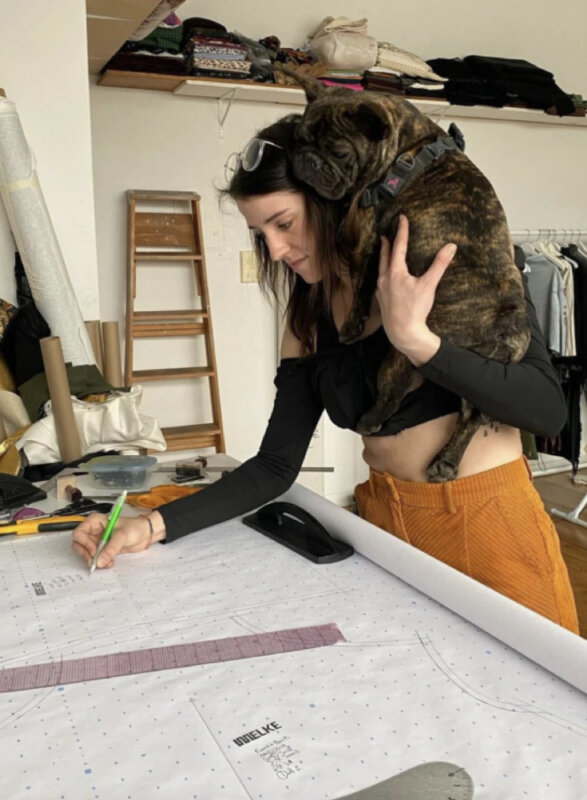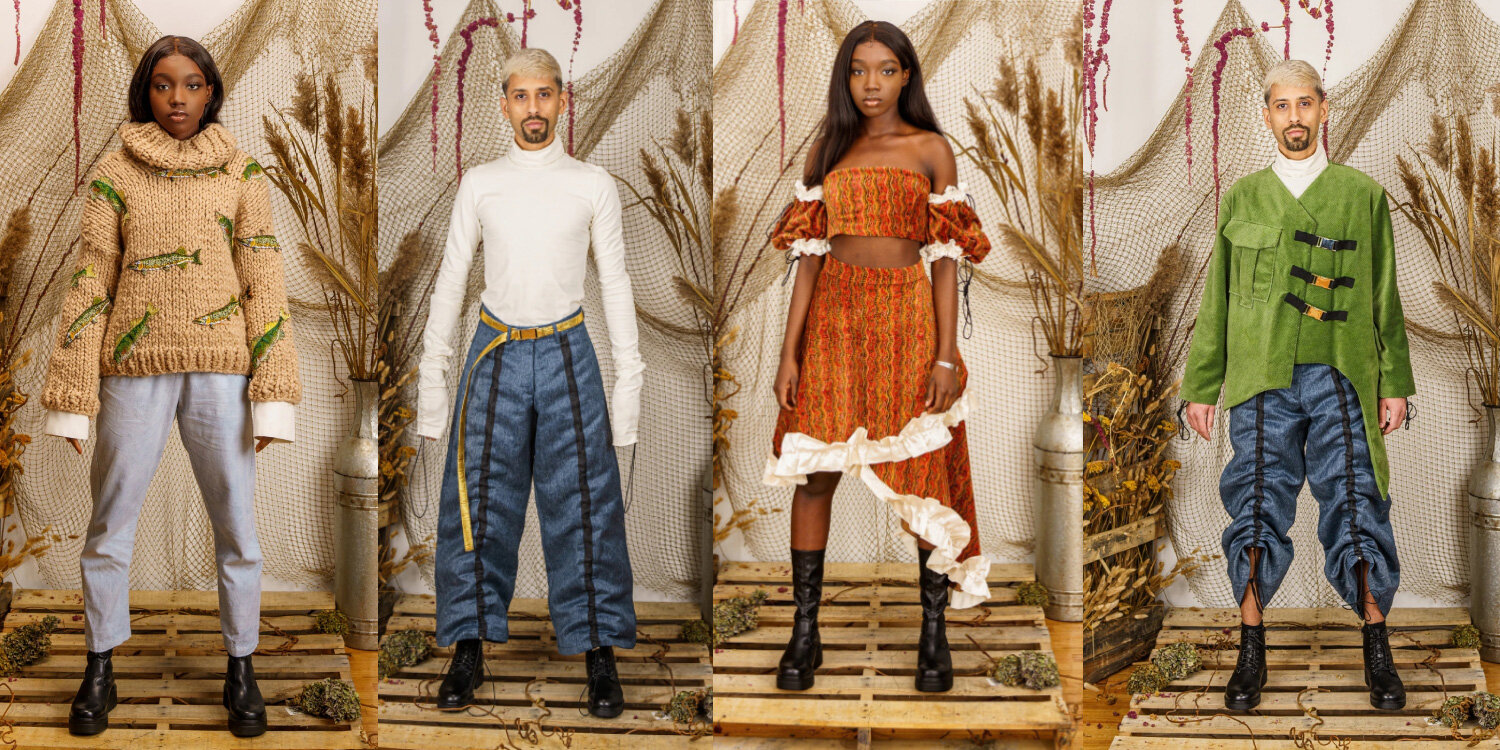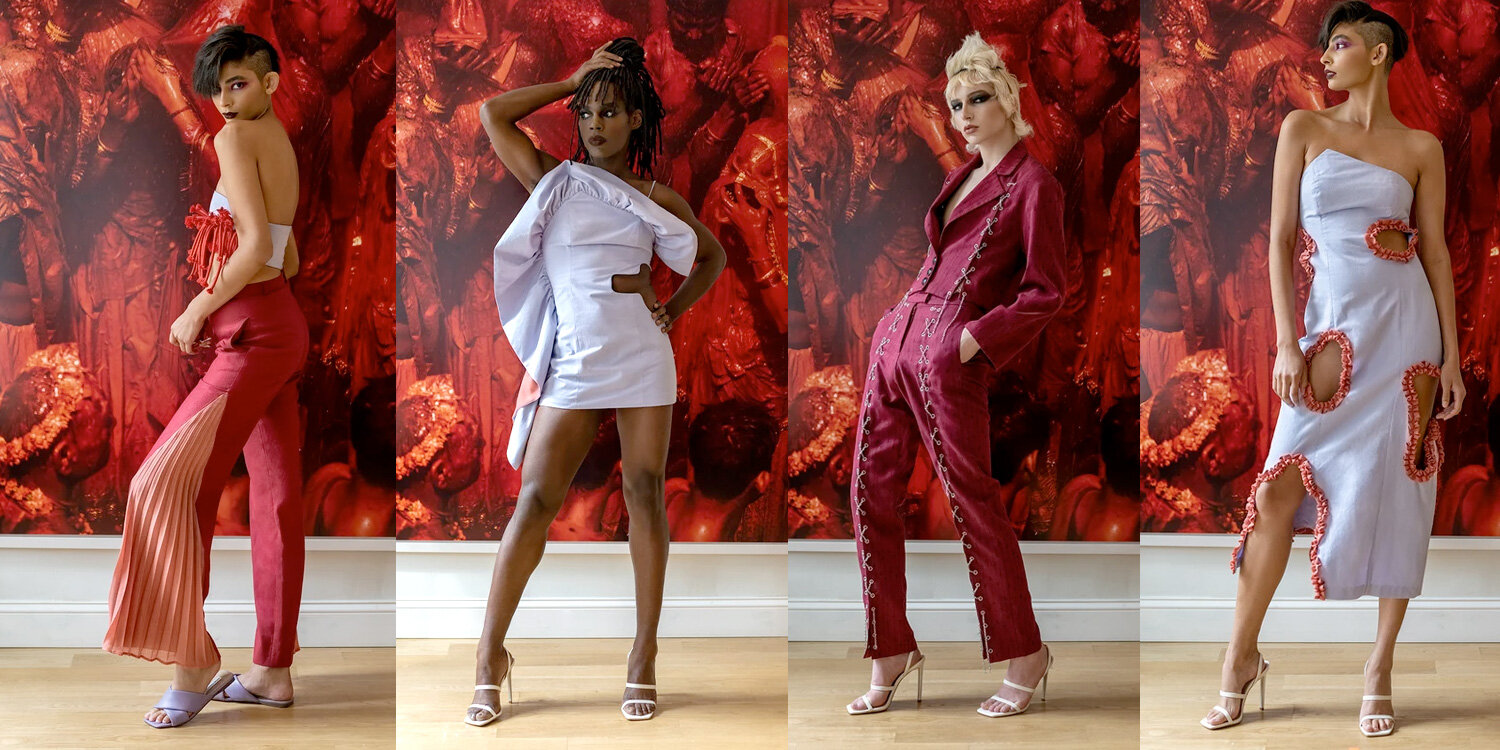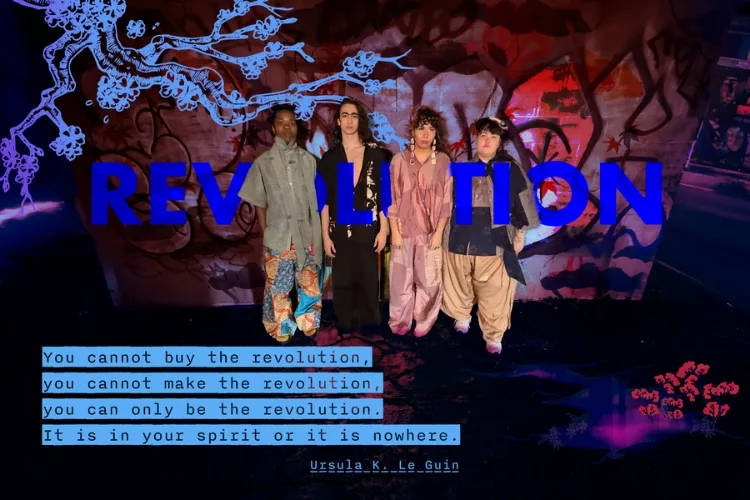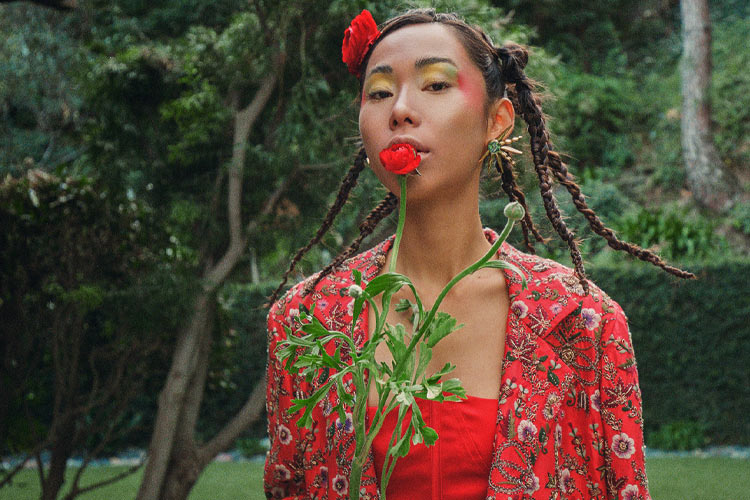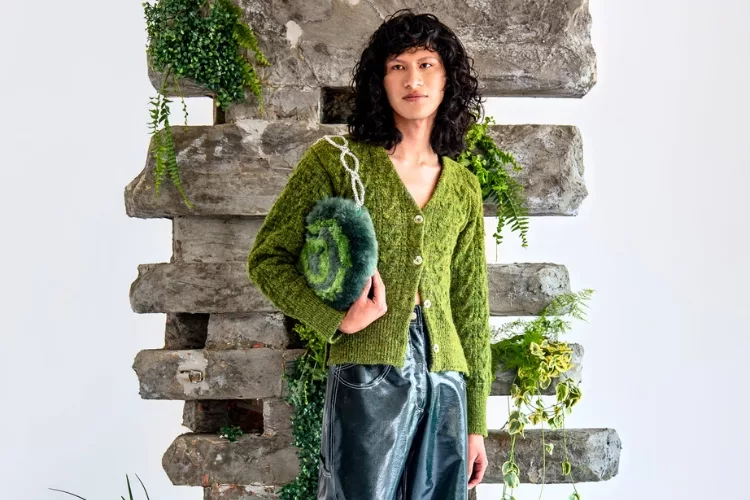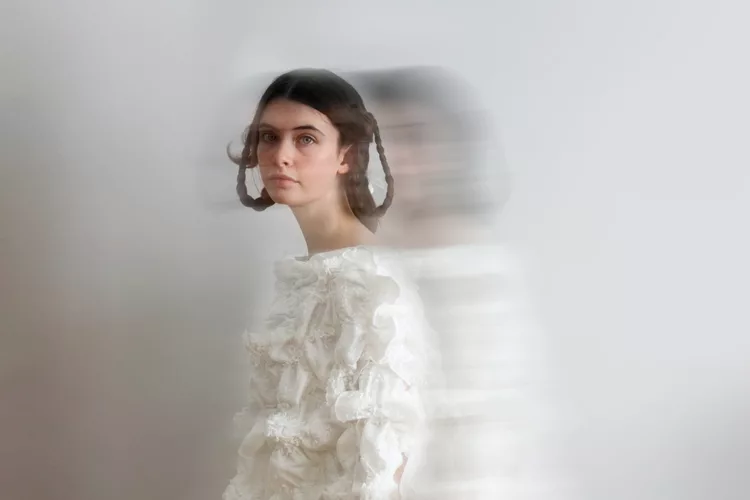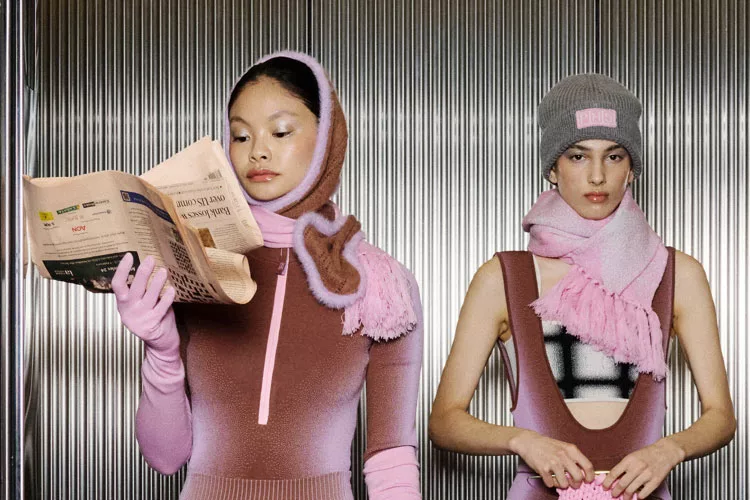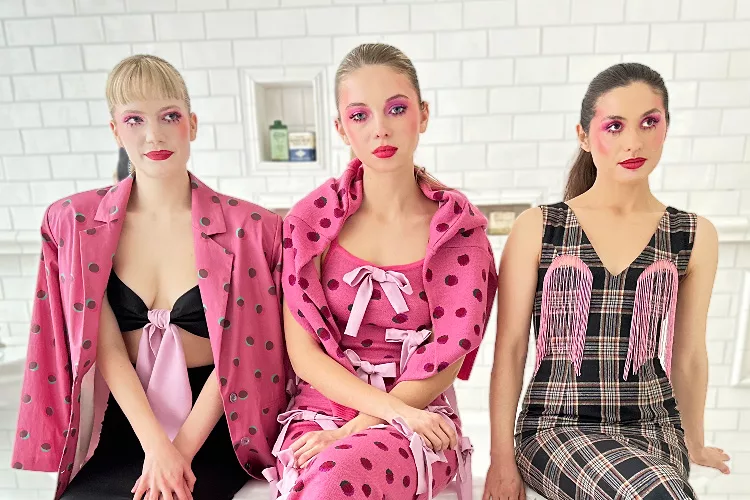“Honestly, sustainability is tough. It’s a lot of work, but we promise to always try our best, to never cut any corners, and to be fully transparent.[…] Things won’t be perfect, and we will be honest about our challenges.”
Emma Gage working with a friend
It’s rare, and refreshing, to see a brand with such honesty and transparency in this era where sustainability buzzwords are reaching a point of saturation in the fashion industry. Based in Manhattan, New York, MELKE is committed to be an all-natural, eco-friendly, and plastic-free brand – recycled plastic included, or should I say, excluded. From undyed material selection to hand-knit herringbone sweaters, each initiative taken by the young brand makes it clear that it’s not there to be another green clothing line, but to redefine sustainability on a systemic level. To Emma Gage, founder of the brand, sustainability has to be more than just paying workers a living wage. She wants to go as far as protecting them from the harsh chemicals from textile treatments, a hidden danger rarely addressed in marketing campaigns commonly found in the sustainable fashion space. MELKE’s high bar of sustainability is something other brands may find challenging to hold up to.
The world of MELKE is whimsical, yet feels intimate, imagined by the daily instances that Emma turns into artful wearables. The brand’s popular Catch of the Day Sweater, a cozy wool knit, interestingly adorned with fish appliques, is “an an ode to the walleyes and muskies” from her fishing trip with her grandparents, is exemplary of the way Emma creates. Despite only starting out in 2020 in the midst of the pandemic, MELKE’s perfect combination of sound ethics and eccentric designs has earned the brand a feature in NYFW 2021. We had the chance to talk to Emma, the mind behind MELKE, to dig deeper into the interesting story behind each look in her AW21 collection, 49.0610° N, 94.8475° W, and her latest collection, The Dragon and the Loon, for SS22.
No Kill Mag/Jacqueline: Congrats on 49.0610° N, 94.8475° W, your first collection! How can we precisely decode the name?
Emma: Thank you! The name of the collection is the coordinates to the location of a fishing trip I took with my grandparents in Northern Minnesota.
What was the inspiration behind it?
I was inspired by a fishing trip up north in Minnesota with my grandparents. We spent a week completely disconnected from the world and surrounded by nature. Every day, the patience and silence of being on the water comforted me, and I would spend our time during shore lunches exploring tiny islands around the lake. Tiny orange mushrooms on trees, turtle shells, and crawfish became the inspiration for many of the garments’ silhouettes and color palettes. I was also drawn to creating garments with convertible details, paying homage to the less fashionable but oh so convenient zip off pant shorts that many outdoors enthusiasts wear, myself included. The interior of our cabin was covered with heavily embroidered and dated curtains which inspired me to use similar materials and drapes throughout the pieces.
How was your first show at New York fashion week 2021?
It was amazing! I grew up wanting to be a fashion designer and having a dream of participating in NYFW, so it was truly incredible, and an honor to be included! There were quite a few moments where I had to manage things I had never done before, but I had a really encouraging team alongside me that helped make everything that much better and successful!
What was it like starting a fashion brand in the midst of the pandemic?
Truthfully, it was the kickstart I had needed. I was working for another brand up until March of 2020 when I lost my job. I’d like to say that right away I jumped into action and started working on Melke right away, but that’s not the case. I was feeling a lot of uncertainty and did a deep dive into playing Sims for a while. At some point, I started making masks to donate which helped me get back into the creative groove and from there, I realized that I finally had the time to do the leg work I need to to start Melke. I had already created the name and logo 3 years prior and had researched LLC and trademark costs, so I took the leap. I spent months researching sustainable fabric suppliers and reaching out to sample makers and production partners. I was working in my apartment to start, bless my roommates! It was difficult dealing with the global shipping issues that everyone faced, but my mindset was just to do the work, put my best foot forward and try. Not being able to really meet people face to face presented struggles when trying to show people the collection, but it certainly helped me build my verbal descriptive skills!
What is something that you will always find in a Melke’s design that can’t be found anywhere else?
Our signature t-shirt made with milk yarn! Yes, actually dairy milk! It’s a by-product from the dairy industry.
How do you define sustainability?
To me, sustainability starts with the social and economic side. I grew up with in a family that worked to combat human sex trafficking and as I grew into my interest in fashion design as well as my career, I knew that focusing on human rights was really important to me. From there, the materials followed, knowing that if I cared about human rights, I cared about their health as well and wouldn’t want people working with harmful materials and synthetics.
Caring about materials being all natural, in turn cares for the planet which circles back to the state humans live in. Another huge aspect that defines sustainability to me is transparency and accountability. There is always room for change and to do better. I’m open to always growing and learning more. I might not be perfect, but I’ll continue to work on sharing as much info as I can with consumers and doing due diligence with my production partners.
To achieve all three pillars of economic, social, and environmental sustainability requires systemic changes, and most brands only focus on the last one. Do you think is it too much to achieve all at once?
It makes me so happy that you’re asking this question! It’s a lot of work, that’s for sure and it isn’t easy. I don’t think it’s too much to achieve at once, but it’s important to not bite off more than you can chew, because that’s when things will start to slide
What do you think about being super transparent online – sharing on Instagram about behind the scenes of photoshoots, production insights, etc. ? Do you think it helps fashion brands nowadays?
To me, the most important part of transparency is with the production and materials. It’s nice for people to see behind the scenes of photoshoots, etc and it allows the customer to connect more with the fact that their clothes are being made and worked on by real people. However, I’d much rather see transparency with production insights, and feel that’s the most helpful. When it comes to sustainability, education and starting the conversation is key. A lot of people feel scared or uncertain about asking questions, because there’s a stigma around not knowing enough, so brands being open and providing the information freely is really helpful. People want to know and are naturally curious!
Tell us more about your special dyeing process. Do you really buy undyed fabrics to dye them in-house by yourself? That’s a lot of work.
I don’t do this process for every piece, but from the first collection there were 4 styles I did this for. The dye comes from Loop of the Loom, and it’s a mineral soil based dye that requires zero hot water and when discarded, since it’s all soil based it causes no harm to the planet.
What I love about this process is that each piece comes out a little bit different and unique.
What about your fabrics? I love how you use Pinatex leather for your Highnoon pants.
Finding fabrics was a fun journey in itself and it’s one that I constantly get to learn from. There are incredibly innovative people out there and seeing the options for natural sustainable materials is incredible!
In regards to leather, I use all plant-based leather, so the pinatex, as you mentioned, and cactus leather as well. In my eyes, a natural material is the best route! Synthetic and recycled leathers still use a lot of chemicals, so plant based is what I prefer to use.
What are your thoughts on fashion going digital?
It really depends on what sort of digital you’re meaning. Is it digital influencers? Digital clothing you can buy and wear in photos? Digital shows? Then you can even get into digital manufacturing techniques.
I’m excited to see how digital can play a role in production and new ways to create, and I appreciate that it makes fashion more accessible. I do believe that people will always want to be able to feel fabric, but there are even fabrics now that have digital elements to them.
You never know what’s possible in the future! I also think there’s a fine line of reality and make believe which can be precarious to tiptoe on. You have two narratives that currently exist, one that focuses on body positivity and another that pushes idealization and perfection.
We’re at the forefront of technology and the digital era, and with every new thing there are positives and negatives, it just depends on how they’re used and who is using them.
One thing you wish people would know more when they buy a clothing item?
Buy the best you can afford, because it will last and will be something you really care for and brings you joy.
If you were not a fashion designer you would be…
Probably sad, but then I’d also love to be a beekeeper.
Can you tell us your plan for the future?
To continue making honest and interesting clothes. I hope to grow with new innovations in regards to sustainability as well.
Visit MELKE at: Instagram | Website
And follow Emma on Instagram!
–Jacqueline Pham

